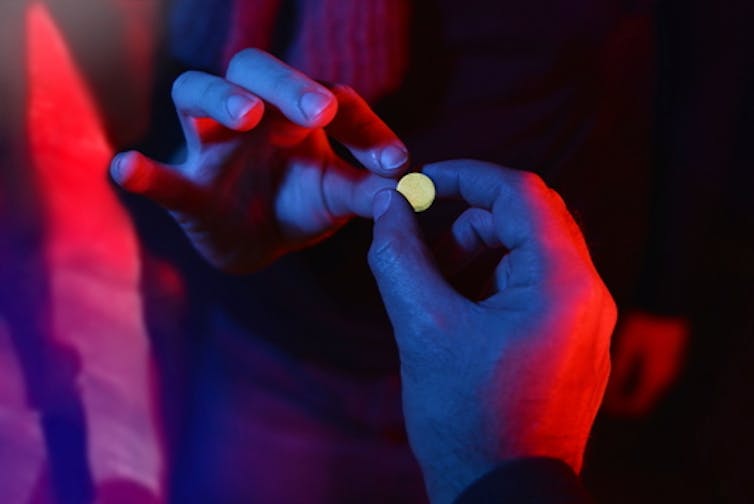Kim Kardashian West and ecstasy: A reminder of the social dangers of the drug
- Written by Joseph Palamar, Associate Professor of Population Health, New York University Langone Medical Center
Kim Kardashian West, who has a reputation for disdaining alcohol, discussed her past use of the drug ecstasy on a recent segment of “Keeping Up with the Kardashians[1].”
“I did ecstasy once, and I got married … I did it again, I made a sex tape … like, everything bad would happen,” she explained.
We often hear about the dangers associated with ecstasy use. We hear about the dangers of taking too much[2], the dangers of overheating[3] while dancing on it for too long, and of unknowingly being exposed to drugs like “bath salts” that are commonly cut[4] into the drug. But focus on potential social harms – which is associated with drug use in general – appears to be rare.
Kim unintentionally constructed a timely PSA which helps raise awareness of potential social harms that may result from use.
What is ecstasy?
Ecstasy, a common name for MDMA, is a stimulant drug with empathogenic[5] effects, meaning it enhances a feeling of “oneness,” openness and empathy. Ecstasy has been among the most popular party drugs since the 1980s and it is well-known for being the “love drug[6],” as its effects often leave users feeling very close – or even temporarily in love – with others. Like most drugs, ecstasy can impair decision-making, and a study published Nov. 19, 2018, demonstrated that ecstasy use increases cooperativeness[7] among people you trust while you’re high.
MDMA is a unique drug. Despite being a Schedule I drug in the U.S. (meaning in part, with no current approved medical uses), last year the Food and Drug Administration[8] granted breakthrough therapy designation for the drug, as it appears to be highly effective in treating post-traumatic stress disorder[9].
The drug is not typically very dangerous when used in a controlled manner, but recreational use can increase risk of harm. For example, many ecstasy pills throughout Europe[10] have been found to have very high, potentially lethal doses, and ecstasy in the U.S., often called “Molly[11]” when in powder form, is often cut with other dangerous drugs like “bath salts[12].”
 Ecstasy, or MDMA, is a popular drug at electronic dance parties.
serpeblu/Shutterstock.com[13]
Ecstasy, or MDMA, is a popular drug at electronic dance parties.
serpeblu/Shutterstock.com[13]
About 2 percent[14] of the U.S. population aged 12 to 34 is estimated to have used ecstasy in the past year, but prevalence of use is much higher among those who attend dance parties. For example, recent estimates suggest a quarter[15] of those who attend electronic dance music parties in New York City have used ecstasy in the past year.
Harm reduction
So one may ask – given the high popularity of use, how do people who use ecstasy ensure they have a safe experience? Often, something called “harm reduction” is practiced.
Harm reduction is the recognition that treatment for people who use substances sometimes is best focused on reducing potential harm from the drug or drugs used, rather than trying to eliminate use altogether. Needle exchange programs[16] are an example. Harm reduction is used when certain behaviors are applied, or avoided, to reduce or prevent adverse outcomes that may result from using a drug.
Ecstasy users, for example, are commonly taught[17] to stay hydrated and take rest breaks from dancing while high. Many ecstasy users also test[18] their drugs to ensure they are using real MDMA and not adulterants such as “bath salts.”
But these are just basic measures to help prevent direct adverse health outcomes. What is largely missing from the discussion is reducing potential adverse social effects associated with use.
Kardashian West implied that use of the drug ecstasy was at least partially responsible for her decisions to get married and to make a sex tape. It is unknown whether Kardashian West was in fact high on ecstasy during these occasions, and it is unknown whether she would have made the decision to partake in these activities if she were not high. However, similar to alcohol[19], drugs like ecstasy can increase risk of engaging in socially regrettable behavior.
People high on a drug like ecstasy may let their guard down, place too much trust in others, and engage in actions they may later regret. And technology further complicates things.
 Everybody is a star on their cellphones, but recording risky behavior has its downsides.
Pressmaster/Shutterstock.com[20]
Everybody is a star on their cellphones, but recording risky behavior has its downsides.
Pressmaster/Shutterstock.com[20]
Mobile phones, which are virtually all now capable of recording, can further facilitate or exacerbate social risk. Mobile phones already provide us with the opportunity to leave regretful texts, phone calls, social media posts, or take or post regretful photos or videos. But introducing mind-altering drugs into the mix can increase risk of such regretful behavior.
Once a post or image is posted or shared with someone, it can remain perpetually available. Alarmingly, “sexting” is already common among young individuals, with almost a third[21] estimated to have ever consensually sexted. A drug like ecstasy that makes you feel sensual and empathetic may further increase risk for engaging in such behavior –consensually or non-consensually.
And social risks are by no means limited to sexting. You may post or say something to someone while high you didn’t intend to share. And if you happen to be in a photo or video while high, you likely wouldn’t want your parent or boss to see it. When drug use is included into the mix of everyday communication, there is increased risk of social harm.
What partiers need to keep in mind
Those who decide to use any drug, legal or illegal, need to keep potential social risks in mind when using. You might not make a sex tape or decide to get married that day, but it’s worth preventing any potential social harm that can result from being high on a drug. If you decide to use a drug like ecstasy, educate yourself on the effects of the drug and how to prevent potential harm. And lay off of social media until you’re no longer inebriated.
References
- ^ “Keeping Up with the Kardashians (www.usatoday.com)
- ^ too much (www.theguardian.com)
- ^ overheating (www.ncbi.nlm.nih.gov)
- ^ cut (www.vice.com)
- ^ empathogenic (www.ncbi.nlm.nih.gov)
- ^ love drug (www.newscientist.com)
- ^ cooperativeness (theconversation.com)
- ^ Food and Drug Administration (maps.org)
- ^ post-traumatic stress disorder (www.ncbi.nlm.nih.gov)
- ^ Europe (www.theguardian.com)
- ^ Molly (www.ncbi.nlm.nih.gov)
- ^ bath salts (www.vice.com)
- ^ serpeblu/Shutterstock.com (www.healthline.com)
- ^ 2 percent (www.ncbi.nlm.nih.gov)
- ^ quarter (www.ncbi.nlm.nih.gov)
- ^ Needle exchange programs (www.healthline.com)
- ^ taught (dancesafe.org)
- ^ test (www.ncbi.nlm.nih.gov)
- ^ alcohol (www.ncbi.nlm.nih.gov)
- ^ Pressmaster/Shutterstock.com (www.shutterstock.com)
- ^ third (www.ncbi.nlm.nih.gov)
Authors: Joseph Palamar, Associate Professor of Population Health, New York University Langone Medical Center

